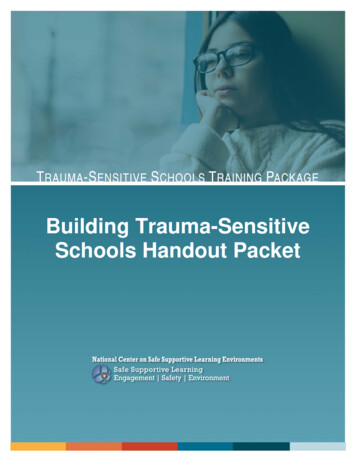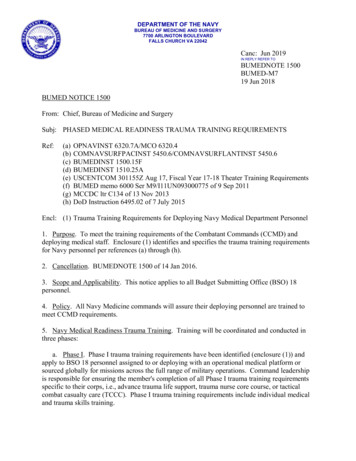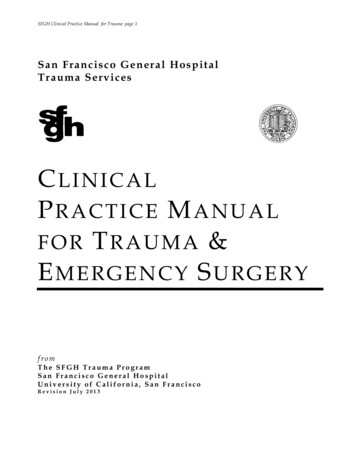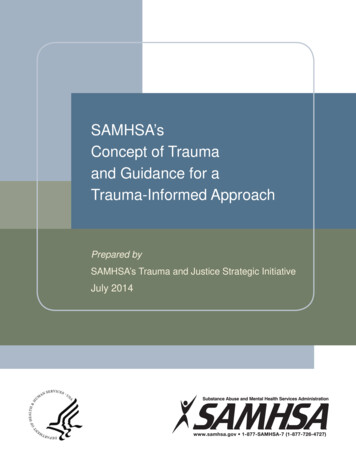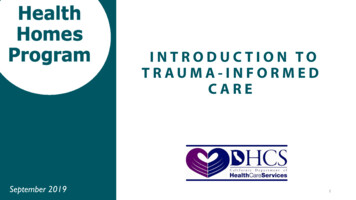
Transcription
Leading Trauma-Sensitive SchoolsAction Guide
C ONTENTSIntroduction . 1Preparing to Use This Guide . 2Timeframe . 2Phase 1: Prepare to Adopt a Trauma-Sensitive Approach . 3Questions to Consider . 3Key Objectives and Sample Benchmarks of Success . 3Activities . 4Resources For Phase 1 . 8Work Group Question Guide to Assess School Readiness for Change . 9Motivation Questions . 10General Capacity Questions . 11Intervention-Specific Capacity Questions . 11Staff Survey to Assess School Readiness for Change. 12Action Plan Template for Phase 1: Prepare to Adopt aTrauma-Sensitive Approach . 15Phase 2: Envision Your Trauma-Sensitive School . 17Questions to Consider . 17Key Objectives and Sample Benchmarks of Success . 17Activities . 18Resources For Phase 2 . 21Work Group Question Guide to Assess Current Practice . 22Staff Survey to Assess Current Practice . 25Staff Development Planning Guide . 28Action Plan Templates for Phase 2: Envision Your Trauma-Sensitive School . 35Domain 1: Support Staff Development . 36Domain 2: Create Safe and Supportive Environments. 38Domain 3: Assess Needs and Provide Support. 40Domain 4: Build Social and Emotional Skills . 42Domain 5: Collaborate with Students and families . 44Domain 6: Adapt Policies and Procedures . 46Maintaining Progress and Monitoring Impact . 48Leading Trauma-Sensitive Schools Action Guideii
Phase 3: Align Trauma Sensitivity With Other Approaches . 50Questions to Consider . 50Key Objectives and Benchmarks for Success . 50Activities . 51Resources For Phase 3 . 52Action Plan Template for Phase 3: Align Trauma Sensitivity With Other Approaches . 53Phase 4: Sustain Trauma Sensitivity . 54Questions to Consider . 54Key Objectives and Sample Benchmarks for Success . 54Activities . 55Resources for Phase 4 . 57Action Plan Template for Phase 4: Sustain Trauma Sensitivity . 58Leading Trauma-Sensitive Schools Action Guideiii
I NTRODUCTIONBuilding trauma-sensitive schools involves changes to school policy, practice, and culture andrequires ongoing efforts to ensure that all students—including students affected by trauma—areexperiencing social, emotional, and educational success. As school and district leaders, youplay a crucial role in bringing about change. Developing and sharing a vision of traumasensitivity and the process for achieving it will help to overcome challenges by charting a courseof action and maintaining focus and commitment among participants.This action guide is intended to be used in conjunction with and after viewing the LeadingTrauma-Sensitive Schools online module, to provide school leadership with a roadmap andtools for implementing a trauma-sensitive approach schoolwide, including recommendations forusing various components of the Trauma-Sensitive Schools Training Package. This guideintroduces a multi-phased process for adopting a trauma-sensitive approach (see Figure 1).Each phase includes key objectives, activities, resources, and an action planning template. Byusing the tools and resources provided, your school will develop and implement custom plansfor adopting a trauma-sensitive approach schoolwide.Please note that if multiple schools across a district are using this guide, school and districtadministrators will need to coordinate efforts and share strategies and lessons learned as eachschool develops and implements its action plans. This process is not intended to replace, but tosupplement, existing frameworks or curricula that your school already may be using.Figure 1. Multi-Phased Process for Adopting a Trauma-Sensitive ApproachPrepare toAdopt eSchoolSustainTraumaSensitivityAlign TraumaSensitivityWith OtherApproachesLeading Trauma-Sensitive Schools Action Guide1
Preparing to Use This GuideThis action guide is designed for school leadership and others invested in leading whole schoolefforts to adopt a trauma-sensitive approach. This guide corresponds to the Leading TraumaSensitive Schools online module, and it is recommended that school leaders review this guide inconjunction with the online module. It is useful for administrators to review this action guide withother colleagues who are in a position to assist you in making decisions about how you mightadopt a trauma-sensitive approach in your school (e.g., fellow administrators, departmentheads, student services personnel, members of other work groups leading aligning efforts suchas school climate teams). If your school already has a work group or entity focused on traumaor related topics, this group may review the module and this guide. See the Facilitation Guidethat accompanies the Leading Trauma-Sensitive Schools online module for recommendationsabout how to facilitate an in-person leader training using these materials.The roadmap for change laid out in this guide can be applied to schools and districts at variedstages in the process of adopting a trauma-sensitive approach. For example, Phase 1 of thisguide outlines activities related to preparing your school to adopt a trauma-sensitive approach,including providing all staff with an overview of foundational concepts using the UnderstandingTrauma and Its Impact e-resource and Building Trauma-Sensitive Schools online module. Ifyour school has already trained staff on trauma and trauma sensitivity, leadership teams canfocus on other activities in Phase 1 related to assessing your school’s readiness for change andexpanding your team to create a multidisciplinary trauma-sensitive work group. If your schoolalready has this infrastructure in place, you may choose to move directly to Phase 2 activitiesrelated to assessing current practice and developing concrete action plans for integratingtrauma-sensitive practices across key domains of school operations.In the course of modifying perspectives and behaviors to become trauma sensitive, you willlikely cycle through the four phases more than once and perhaps concurrently at times, as theschool itself refines its practices or as new issues arise. Please note, if you are not a schooladministrator, but you are in a position to introduce school leadership to trauma sensitivity,please refer to the Implementation Guide for recommendations on how and when to introducetraining package components, including this action guide.TimeframeAdopting a trauma-sensitive approach requires ongoing, focused work over the course of theschool year. You may begin this process at any time, but certain periods of time, such as thesummer or early fall, may be optimal for developing and beginning to carry out plans related tostaff training and setting goals for adopting trauma-sensitive practices. Please keep in mind thatthis is an ongoing process, and it can take several years to fully embed this approach.Leading Trauma-Sensitive Schools Action Guide2
Phase1P REPARE TO A DOPT A T RAUMA -S ENSITIVEA PPROACHEffective preparation is essential for achieving true and lasting systems changerelated to trauma sensitivity. Preparing to successfully adopt a trauma-sensitive approachschool- or districtwide involves educating fellow leaders, staff, families, and community partnersto ensure a common understanding and rationale for change; assessing readiness for change;and establishing the structures for supporting, monitoring, and sustaining new practices. Thetime it takes for leaders to prepare their schools and districts to adopt a trauma-sensitiveapproach will vary based on degree of buy-in and readiness for change at all levels of thesystem (e.g., administrative commitment, staff motivation, current capacity of the school ordistrict to adopt a new approach).Questions to ConsiderSchool leadership teams consider the following questions during Phase 1: What is our intention as it relates to adopting a trauma-sensitive approach? Are all staff on the same page in understanding trauma and trauma sensitivity? Do we have the infrastructure in place for supporting schoolwide adoption of traumasensitivity (e.g., a multidisciplinary trauma-sensitive work group)? Are we ready to more fully adopt a trauma-sensitive approach?Key Objectives and Sample Benchmarks of SuccessKey objectives related to preparing your school to adopt a trauma-sensitive approach areincluded here, along with sample benchmarks of success.Key ObjectivesSample BenchmarkLeaders have articulated a commitmentto adopting a trauma-sensitive approach. Leaders have developed and implemented acommunication plan for informing staff about plans forintegrating a trauma-sensitive approach.Resources have been allocated tosupport the adoption of a traumasensitive approach. Training to support change efforts has been built in toprofessional development plans for the school year.All school staff members have a baselineunderstanding of trauma and its impacton students and staff as well as what itmeans to be a trauma-sensitive school. All school staff members have completed theUnderstanding Trauma and Its Impact e-resource andthe Building Trauma-Sensitive Schools online module.Leading Trauma-Sensitive Schools Action Guide3
The school has a formal multidisciplinarytrauma-sensitive work group thatincludes student and family voices and issupported by the leadership. The school is ready to more fully adopt atrauma-sensitive approach. Personnel in different staff roles have joined theschool’s trauma-sensitive work group.Students and their families participate in the traumasensitive work group.School leaders have affirmed to staff their commitmentto adopting trauma sensitivity schoolwide.The majority of school staff expresses feelingmotivated to adopt a trauma-sensitive approach.Activities1. Develop an action plan.Use the action planning template for Phase 1 (p. 15) to plan for how you will do thefollowing: Communicate your commitment to trauma-sensitivity Allocate resources Educate staff Create a trauma-sensitive work group Assess your school’s readiness for changeOnce your action plan is complete, we recommend implementing the plan in the orderoutlined in activities 2 through 6 below. Consider how you may incorporate the guidanceoffered for each activity into your action plan.2. Communicate your commitment to adopting a trauma-sensitive approach.School leaders communicate to staff a commitment to adopting a schoolwide traumasensitive approach. You can accomplish this through a number of actions: Introduce the topic as part of staff or team meetings and provide opportunities todiscuss and illustrate what this might look like with staff. Use the roadmap outlined in this action guide to provide staff with a vision for thechange process at the school. Attend and follow up on all in-person training events; Ensure that staff members are able to engage fully in the change process (e.g.,provide adequate time and resources); and Model trauma sensitivity with students, families, and school staff.3. Allocate sufficient resources to support the change process.Leaders can begin by considering how trauma sensitivity aligns with other initiatives alreadyin place at your school. It may be possible to consolidate resources by incorporating trauma-Leading Trauma-Sensitive Schools Action Guide4
related trainings and activities into other processes that are already well resourced.Essential resources include the following: Access to computers for all staff to review online components Adequate time and coverage for work group staff to meet Time and coverage for ongoing professional development activities related totrauma sensitivity Materials for professional development events (e.g., photocopies of activities,discussion guides, accompanying slides; paper and markers for discussion) Time and mechanisms for evaluating impact Technology for conducting staff surveys and assessments (e.g., SurveyMonkey or related platforms) Outside consultation and support around trauma sensitivity if needed4. Educate all staff about trauma and its effects as well as trauma-sensitive schools.Such education builds a common awareness and understanding of trauma and increasesbuy-in to the change process. Education includes everyone: administrators; teachers;paraprofessionals; student services staff such as school counselors, social workers andpsychologists; nurses; office staff; bus drivers; food services staff; and maintenanceworkers. If staff are new to trauma concepts, we recommend that school leaders plan tointroduce training package materials in the following sequence:a. All staff receives access to view the Understanding Trauma and Its Impact e-resourceindependently via computer or tablet.b. Leadership teams plan for follow-up training with staff using the Understanding Traumaand Its Impact companion slide deck and activity packet to support in-person trainingand discussion sessions to reinforce concepts covered in the e-resource. It isrecommended that follow-up in-person training occurs to ensure that all staff areunderstanding core concepts and to gauge buy-in related to more fully addressingtrauma across the school.The Understanding Trauma and Its Impact activity packet includes activities anddiscussion questions along with pre- and post-training knowledge surveys and asatisfaction survey. Leaders will need to determine which staff members are comfortableleading in-person training sessions on the e-resource material. With limited time forprofessional development, you may divide slide presentation and activities into multi-parttraining sessions and cover them during staff meetings or during other professionaldevelopment events. This approach fosters ongoing dialogue and learning. If your schoolhas already provided staff training on trauma, the leadership team may consider ways touse the Understanding Trauma and Its Impact e-resource and Building Trauma-SensitiveSchools online module to supplement existing training where appropriate.Leading Trauma-Sensitive Schools Action Guide5
If school leaders and trauma-sensitive work groups choose not to conduct an in-persontraining after staff reviews the Understanding Trauma and Its Impact e-resource, youmay choose to use the pre- and posttraining knowledge surveys in the activity packetbefore and after staff view the e-resource. School leaders may consider sending a pretraining knowledge survey to all staff via Survey Monkey prior to having staff view the eresource and sending a posttraining knowledge survey once all staff have viewed the eresource to assess for change.c. Leaders conduct in-person staff trainings using the Building Trauma-Sensitive Schoolsonline module. The module familiarizes the staff with the concept of trauma sensitivityand with trauma-sensitive practices that can be employed schoolwide. The training isdivided in to multiple sections, each with corresponding checklists, worksheets, practiceguides, and discussion questions for supporting staff in adopting a trauma-sensitiveapproach. The module is best viewed in a group setting, with a lead trainer who can stopthe group at various points to use the module handouts to foster staff discussion. Themodule can be viewed in segments for shorter professional development sessions.Plans for educating staff should dictate clear timeframes for completing trainings andshould offer opportunities for staff feedback about the material. Feedback will help youmonitor completion and ascertain the level of buy-in for trauma sensitivity at your school.If live, group discussions with all staff are difficult to arrange, you could gather feedbackby using surveys after staff view each resource. If discussions happen in person, it isimportant to establish a safe space where staff feel that they can be honest in theirfeedback. Questions for group discussions or staff survey can be short and simple: What was your general impression of the material? What was familiar to you? What was new for you? What surprised you? Was this information relevant to your interactions with students and families? How do you see trauma affecting students and staff? How interested are you in learning more?Materials in the Trauma-Sensitive Schools Training Package are targeted to school staff, butleaders should consider how the different components of the package can be introduced toparents and community partners. For example, leaders may arrange for parent advisorygroups and community mental health partners to view the e-resource and the BuildingTrauma-Sensitive Schools online module. Leaders should gather feedback from thesegroups about the materials and communicate their intention to involve parents andcommunity partners in the change process.Leading Trauma-Sensitive Schools Action Guide6
5. Create a trauma-sensitive work group.The team of school leaders initiating the change process should grow and/or evolve aftertraining to include staff members in different roles across the school (e.g., teachers, studentservices staff such as school counselors and school social workers, and other noninstructional staff) who are willing to support these efforts. If your school already has workgroups dedicated to similar efforts, such as a school improvement or climate team, you canconsider ways to align them in Phase 3 (p. 50). The work group is most effective when itrepresents the larger school community, which also means including students, families, andcommunity partners. The work group plans for how to ensure all voices are represented inthe expanded group. Over time, you may consider rotating staff members on the work groupto avoid burnout and ensure new perspectives.6. Assess your school’s readiness for change.The newly formed trauma-sensitive work group makes plans for assessing your school’sreadiness to adopt a trauma-sensitive approach and addressing any gaps in readiness. Thework group can hold internal discussions using the Work Group Question Guide to AssessSchool Readiness for Change (p. 9). To obtain information from all staff members, the StaffSurvey to Assess School Readiness for Change (p. 12) is a tool that is easy to distributeand from which responses are simple to tabulate.Leading Trauma-Sensitive Schools Action Guide7
R ESOURCES F OR P HASE 1The following resources for supporting Phase 1 activities and objectives are taken from thevarious components of the Trauma-Sensitive Schools Training Package, including this actionguide: Understanding Trauma and Its Impact E-Resource Understanding Trauma and Its Impact Companion Slide Presentation Understanding Trauma and Its Impact Activity Packet Building Trauma-Sensitive Schools training module Building Trauma-Sensitive Schools Facilitation Guide Work Group Question Guide to Assess School Readiness for Change, p. 9 Staff Survey to Assess School Readiness for Change, p. 12Leading Trauma-Sensitive Schools Action Guide8
W ORK G ROUP Q UESTION G UIDE TOA SSESS S CHOOL R EADINESS FOR C HANGEThe discussion questions on the following two pages will help your trauma-sensitive work groupexamine your school’s level of readiness and identify potential readiness issues in three areas: Motivation. How motivated is the school community to adopt a trauma-sensitive approach? General Capacity. How well is the school currently operating? Is there a strong foundationfrom which to build? Intervention-Specific Capacity. What specific capacities are needed to adopt a traumasensitive approach?Instructions1. Print copies as needed.2. Assign a work group member to take notes during the discussion.3. One person may facilitate the discussion while another takes notes. Alternatively, key pointscould be written on paper large enough that all can see during the discussion to ensureideas are reflected accurately.4. Discuss questions during one or more trauma work group meetings. Identify potentialreadiness issues related to motivation and capacity.5. Save notes to use along with feedback from the staff survey about school readiness forchange. This will inform your action plans for school readiness.Leading Trauma-Sensitive Schools Action Guide9
M OTIVATION Q UESTIONSQuestions regarding the school community’s motivation to implement a trauma-sensitiveapproach explore staff perceptions regarding the need to address trauma, the feasibility ofimplementation, and the difficulty of changing beliefs and practices concerning trauma. Lowmotivation indicates a need to learn more about potential barriers and challenges and reasonswhy staff members are not motivated to adopt a new approach.If motivation is low, school leaders may consider spending more time educating staff abouttrauma and its impact as well as facilitating discussions with staff about the relevance of traumato their work. Reasons for low buy-in may be less about the topic than about the current climateor culture of the school, in which case addressing issues related to general capacity may be acritical first step (see general capacity questions on p. 11).Motivation1. How is a trauma-sensitive approach different from what is currently in place universally tosupport students?2. To what extent does trauma sensitivity add value to existing practices and approaches?3. How consistent is trauma sensitivity with existing school values and cultural norms?4. How compatible is a trauma-sensitive approach with other programs or approaches that havealready been implemented at your school?5. How difficult will it be to implement a trauma-sensitive approach schoolwide?6. How will outcomes related to trauma sensitivity be visible to staff members (for example,improved student behavior, more support for staff members, decrease in crises)?7. To what extent is trauma sensitivity seen as a priority compared to other approaches beingimplemented?Leading Trauma-Sensitive Schools Action Guide10
G ENERAL C APACITY Q UESTIONSGeneral capacity refers to different aspects of a school’s current functioning, including staffing,leadership, and infrastructure. These aspects also account for organizational culture andclimate. If the general operational capacity seems low, schools may need to focus onstrengthening their capacity to operate effectively before implementing a new approach. Thisprocess may require adjustments to the current infrastructure to improve communication andstaff support, transparency between administrators and other school staff within and outside ofthe school building, staff morale, and general skill-building efforts.General Capacity1.2.3.4.5.How well is the school currently operating?How does the staff currently feel about their work environment?How supportive is the leadership of approaches currently used by the school?How receptive is school staff to change?What structures are in place to support day-to-day school functioning (e.g., staff size andexperience; opportunities for planning, training, and collaboration; communication channels)?6. What are the general skills, expertise, and education of school staff members in various roles(e.g., administrators, teachers, student service, and support staff)?Intervention-Specific Capacity QuestionsTo determine the school’s readiness to adopt a new approach, consider the specific capacitiesnecessary to adopt a trauma-sensitive approach. At this stage, leaders identify the plans theyneed to put in place to build the support, resources, knowledge, and skills needed to build andmaintain a trauma-sensitive school.Intervention-Specific Capacity1.2.3.4.What knowledge, skills, and abilities are needed to become a trauma-sensitive school?Who in the school will lead the process and champion trauma sensitivity?To what extent is there strong, demonstrated administrative support for trauma sensitivity?What additional processes or structures need to be in place to support this process?Leading Trauma-Sensitive Schools Action Guide11
S TAFF S URVEY TO A SSESS S CHOOL R EADINESS FOR C HANGERather than ask labor-intensive, open-ended questions, the staff survey presents a series ofstatements showing readiness and asks staff members to indicate the extent to which theyagree with each one.The school readiness survey is designed to be administered only after staff members havecompleted the Understanding Trauma and Its Impact e-resource and the Building TraumaSensitive Schools module. Once they have done so, respondents will be better prepared toassess their school’s readiness to adopt a trauma-sensitive approach.At some point, work groups may consider adapting this survey to gather student and parentperspectives on your school’s readiness for trauma sensitivity.Instructions1. Determine the method of administration. For example, you may print and distribute papercopies of the survey during a staff meeting, or you may use a simple online survey tool suchas SurveyMonkey which contains built-in mechanisms for tallying and reviewing results.2. Provide staff with access to the survey, explain the reason you need their input, and givethem a time limit for completion.3. Compile the survey responses and combine the information with notes from the work groupdiscussions to identify strengths related to motivation and capacity for change that theschool can use in the effort to incorporate a trauma-sensitive approach. Use it also topinpoint gaps and challenges for which you may need to develop additional action steps toensure your school is ready to adopt a trauma-sensitive approach.Note: The trauma-sensitive work group should ensure that all staff have access to surveyresults to help build buy-in and a shared understanding of the school’s strengths and gapsrelated to readiness to adopt a trauma-sensitive approach.Leading Trauma-Sensitive Schools Action Guide12
Staff Survey to Assess School Readiness for ChangePlease rate on a scale of 1–4 (1: strongly disagree–4: strongly agree)the extent to which you agree with the following reeA trauma-sensitive approach is different fromexisting universal supports already in place forstudents at our school.12342. Trauma sensitivity would add significant value toexisting practices and approaches at our school.12343. Trauma sensitivity is consistent with our schoolvalues and culture.12344. A trauma-sensitive approach is compatible (alignswell) with existing programs and approachesalready being used at our school.12345. Adopting a trauma-sensitive approach would helpus meet the needs of students and staff in ourschool community.12346. It is realistic and achievable for our school toimplement trauma-sensitive practices schoolwide.12347. Positive outcomes from adopting a trauma-sensitiveapproach will be easily visible to staff.12348. Adopting a trauma-sensitive approach is a priorityfor our reeMy school operates well in the day-to-daymanner.12342. Staff receives the support they need in
Technology for conducting staff surveys and assessments ( e.g., SurveyMonkey or related platforms) Outside consultation and support around trauma sensitivity if needed 4. Educate all staff about trauma and its effects as well astrauma -sensitive schools. Such education builds a common awareness and understanding of trauma and increases

